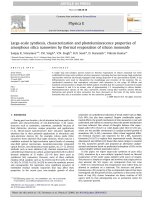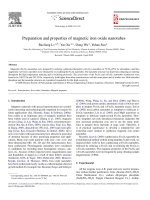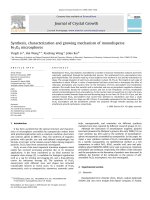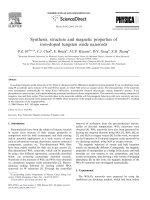- Trang chủ >>
- Khoa Học Tự Nhiên >>
- Vật lý
files lectures nanotechnology synthesis structures and properties
Bạn đang xem bản rút gọn của tài liệu. Xem và tải ngay bản đầy đủ của tài liệu tại đây (1.77 MB, 71 trang )
Nanotechnology: Synthesis, Structures and Properties
‘a review of current carbon nanomaterials and other nanoparticle technologies’
2
1. Introduction
1.1 introduction to nanotechnology
Research on new materials technology is attracting the attention of researchers all
over the world. Developments are being made to improve the properties of the
materials and to find alternative precursors that can give desirable properties on the
materials.
Nanotechnology, which is one of the new technologies, refers to the development of
devices, structures, and systems whose size varies from 1 to 100 nanometers (nm).
The last decade has seen advancement in every side of nanotechnology such as:
nanoparticles and powders; nanolayers and coats; electrical, optic and mechanical
nanodevices; and nanostructured biological materials. Presently, nanotechnology is
estimated to be influential in the next 20-30 years, in all fields of science and
technology.
Nanotechnology is receiving a lot of attention of late across the globe. The term nano
originates etymologically from the Greek, and it means “dwarf.” The term indicates
physical dimensions that are in the range of one-billionth of a meter. This scale is
called colloquially nanometer scale, or also nanoscale. One nanometer is
approximately the length of two hydrogen atoms. Nanotechnology relates to the
design, creation, and utilization of materials whose constituent structures exist at the
nanoscale; these constituent structures can, by convention, be up to 100 nm in size.
Nanotechnology is a growing field that explores electrical, optical, and magnetic
activity as well as structural behavior at the molecular and submolecular level. One
3
of the practical applications of nanotechnology (but certainly not the only one) is the
science of constructing computer chips and other devices using nanoscale building
elements. Nanoscale structures permit the control of fundamental properties of
materials without changing the materials’ chemical status.
As it might be inferred, nanotechnology is highly interdisciplinary as a field, and it
requires knowledge drawn from a variety of scientific and engineering arenas:
Designing at the nanoscale is working in a world where physics, chemistry, electrical
engineering, mechanical engineering, and even biology become unified into an
integrated field. “Building blocks” for nanomaterials include carbon-based
components and organics, semiconductors, metals, and metal oxides; nanomaterials
are the
infrastructure, or building blocks, for nanotechnology.
The term nanotechnology was introduced by Nori Taniguchi in 1974 at the Tokyo
International Conference on Production Engineering. He used the word to describe
ultrafine machining: the processing of a material to nanoscale precision. This work
was focused on studying the mechanisms of machining hard and brittle materials
such as quartz crystals, silicon, and alumina ceramics by ultrasonic machining. Years
earlier, in a lecture at the annual meeting of the American Physical Society in 1959
(There’s Plenty of Room at the Bottom) American Physicist and Nobel Laureate
Richard Feynman argued (although he did not coin or use the word nanotechnology)
that the scanning electron microscope could be improved in resolution and stability,
so that one would be able to “see” atoms. Feynman proceeded to predict the ability to
arrange atoms the way a researcher would want them, within the bounds of chemical
stability, in order to build tiny structures that in turn would lead to molecular or
atomic synthesis of materials [6]. Based on Feynman’s idea, K. E. Drexler advanced
4
the idea of “molecular nanotechnology” in 1986 in the book Engines of Creation,
where he postulated the concept of using nanoscale molecular structures to act in a
machinelike manner to guide and activate the synthesis of larger molecules. Drexler
proposed the use of a large number (billions) of roboticlike machines called
“assemblers” (or nanobots) that would form the basis of a molecular manufacturing
technology capable of building literally anything atom by atom and molecule by
molecule
Nanomaterials give impetus to new applications of the (nano)technology becausethey
exhibit novel optical, electric ,and/or magnetic properties. The first generation of
nanotechnology (late 1990s–early 2000s) focused on performance enhancements to
existing micromaterials; the second generation of nanotechnology (slated for2006–
2007) will start employing nanomaterials in much more significant and radical ways.
Nanomaterials with structural features at the nanoscale can be found in the form of
clusters, thin films, multilayers, and nanocrystalline materials often expressed by the
dimensionality of 0,1,2 and 3; the materials of interest include metals, amorphous
and crystalline alloys, semiconductors, oxides, nitride and carbide ceramics in the
form of clusters, thin films, multilayers, and bulk nanocrystalline materials.
All products are manufactured from atoms, however, interestingly, the properties of
those products depend on how those atoms are arranged. For example, by rear-
ranging the atoms in coal (carbon),one can make diamonds. It should be noted that
current manufacturing techniques are very rudimentary at the atomic/molecular level:
casting, grinding, milling, and even lithography move atoms in bulk rather than in a
“choreographed”or “highly controlled”fashion. On the other hand, with
nanotechnology one is able to assemble the fundamental building blocks of
nature(atoms, molecules,etc.),within the constraints of the laws of physics, but in
5
ways that may not occur naturally or in ways to create some existing structure but by
synthesizing it out of cheaper forms or constituent elements. Nanomaterials often
have properties dramatically different from their bulk-scale counterparts; for
example, nanocrystalline copper is five times harder than ordinary copper with its
micrometer-sized crystalline structure. A goal of nanotechnology is to close the size
gap between the smallest lithographically fabricated structures and chemically
synthesized large molecules.
2.1 History of fullerenes
Fullerenes are large, closed-cage, carbon clusters and have several special properties
that were not found in any other compound before. Therefore, fullerenes in general
form an interesting class of compounds that surely will be used in future technologies
and applications. Before the first synthesis and detection of the smaller fullerenes
C60 and C70, it was generally accepted that these large spherical molecules were
unstable. However, some Russian scientists
1,2
already had calculated that C60 in the
gas phase was stable and had a relatively large band gap.
As is the case with numerous, important scientific discoveries, fullerenes were
accidentally discovered. In 1985, Kroto and Smalley
3
found strange results in mass
spectra of evaporated carbon samples. Herewith, fullerenes were discovered and their
stability in the gas phase was proven. The search for other fullerenes had started.
6
Figure 1.1: structures of fullerenes.
As is the case with numerous, important scientific discoveries, fullerenes were
accidentally discovered. In 1985, Kroto and Smalley found strange results in mass
spectra of evaporated carbon samples. Herewith, fullerenes were discovered and their
stability in the gas phase was proven. The search for other fullerenes had started.
There are many other fullerenes of different shapes and sizes, such as C70, C82 etc.
2.2 Carbon nanotube structure
With the revolutionary discovery of so-called fullerenes and carbon nanotubes,
different research fields in the domain of carbon experienced an enormous boom.
Fullerenes are spherical molecules, the smallest of which composed of 60 carbon
atoms that are arranged like the edges of the hexagons and pentagons on a football.
Nanotubes can be described as a rolled-up tubular shell of graphene sheet [see Figure
2.2a], which is made of benzene-type hexagonal rings of carbon atoms. The body of
7
the tubular shell is thus mainly made of hexagonal rings (in a sheet) of carbon atoms,
whereas the ends are capped by half-dome shaped half-fullerene molecules. Due to
their special one-dimensional form, they have interesting physical properties like
they have metallic or semiconducting electrical conductivity depending on the
chirality’s of the carbon atoms in the tube. Nanotubes have a large geometric aspect
ratio and they are the first nanocavities. This and other properties one would like to
use in different applications e.g. as electrode material in super capacitors and
hydrogen storage material for the fuel storage or as field emitters in flat panel
displays [Deepak et al., 2003].
Figure 1.2:(a) A graphene sheet made of C atoms placed at the corners of hexagons
forming the lattice with arrows AA and ZZ denoting the rolling direction of the sheet
to make (b) a (5,5) armchair nanotube and (c) a (10,0) zigzag nanotube [Deepak et
al., 2003].
8
Carbon nanotubes may be classified into three different types: armchair, zigzag, and
chiral nanotubes, depending on how the two-dimensional graphene sheet is "rolled
up". The first of the three structural categories is zigzag, which is named for the
pattern of hexagons as one move circumferentially around the body of the tubule
(Figure 1.3(a)). The second of these nanotube structures is termed armchair, which
describes one of the two conformers of cyclohexane, a hexagon of carbon atoms, and
describes the shape of the hexagons as one move around the body of the tubule
(Figure 1.3(c)). The third form is known as chiral (Figure 1.3(b)) and is believed to
be the most commonly occurring SWNT. The name chiral means handedness and
indicates that the tubes may twist in either direction. The geometry of the chiral
SWCNT lies between that of the armchair and zigzag SWCNTs (see Figure 1.3 (b))
[Ray et al., 2002].
A single walled carbon nanotube (SWCNT) can be described as a rolled up graphene
sheet that is closed at each end with half of a fullerene. A nanotube is usually
characterized by its diameter d
t
and the chiral angle θ (0 ≤ |θ| ≤ 30°) (Figure 2.5). The
chiral vector C
h
is defined with the two integers (n, m) and the basis vectors of the
graphene sheet [Harris, 2001; Dresselhaus et al., 1998 & 2001; Thomas, 1997and
Saito et al., 1993]:
C
h
= n*a
1
+m*a
2
(1.1)
The so-called chiral vector of the nanotube, C
h
, where a
1
and a
2
are unit vectors in
the two-dimensional hexagonal lattice, and n and m are integers. Another important
parameter is the chiral angle, which is the angle between C
h
and a [Kiang et al.,
1998].
9
Figure 1.3: (a) Zig-Zag Single-Walled Nanotube. Note the zig-zag pattern around
circumference and m = 0. (b) Chiral Single-Walled Nanotube. Note twisting of
hexagons around tubule body. (c) Armchair Single-Walled Nanotube. Note the chair-
like pattern around circumference and n = m [Harris, 2001].
10
Figure 1.4: Schematic illustrations of the structures of (A) armchair, (B) zigzag,
and(C) chiral SWNTs. Projections normal to the tube axis and perspective views
along the tube axis are on the top and bottom, respectively. (D) Tunneling
electron microscope image showing the helical structure of a 1.3-nm-diameter
chiral SWNT. (E) Transmission electron microscope (TEM) image of a MWNT
containing a concentrically nested array of nine SWNTs. (F) TEM micrograph
showing the lateral packing of 1.4-nm-diameter SWNTs in a bundle. (G)
Scanning electron microscope (SEM) image of an array of MWNTs grown as a
nanotube forest [Ray et al., 2002].
To discriminate between different types of carbon nanotubes, the chiral angle and
vector play an important role in determining the important properties of nanotubes.
Armchair nanotubes are formed when n = m and the chiral angle is 30°. Zigzag
nanotubes are formed when either n or m is zero and the chiral angle is 0°. All other
nanotubes, with chiral angles intermediate between 0° and 30°, are known as chiral
nanotubes. The properties of nanotubes are also determined by their diameter, which
depends on n and m. A nanotube is usually characterized by its diameter d
t
and the
11
chiral angle θ (0 ≤ |θ| ≤ 30°). The integers (n, m) determine d
t
and θ [Dresselhaus et
al., 1998 & 2001 and Ray et al., 2002]:
3
nmmn
m
nmmnd
t
++
=++=
22
22
2
3
sin,
1
θ
π
Figure 1.5: Diagram showing rolling direction of nanotube [Dresselhaus et al., 1998].
Multi walled carbon nanotubes (MWCNT) are nanotubes with more than one
graphene cylinder nested one into another (Figure 1.6). The spacing of intershell by
using image of TEM with high resolution; spacing found to vary from 0.34,
augmenting with the diameter of tube diminishing. The biggest spacing for the
smallest diameter is allocated in the high curve, following in a distasteful force
augmented, linked to the diameter diminished by the shells of CNTs (Saito et al.,
1993). The value of 0.34 nm spacing in the bulk graphite crystal is approximately
that of the CNTs. However, a closer study revealed that the mean value of the
interlayer spacing is 0.3444 ± 0.001 nm; the values in CNTs are larger, by a few
percent, than those in the bulk graphite crystal (Ru, 2000b). According to theoretical
(1.2)
12
calculations the distance between two layers is d = 3.39 Å, slightly bigger than in
graphite. Based on TEM images, the interlayer separation of d = 3.4 Å is commonly
reported for MWCNT [Ebbesen, 1997].
Figure 1.6: Structures of carbon nanotubes [www.iljinnanotech.co.kr
, 2002].
In figure 1.7, carbon cones are also shown. It can be considered as a gradual
transition from a large diameter to a smaller one without defects in the wall of the
cone but with fewer pentagons in the end cap.
13
Figure 1.7: Different structures of MWCNTs. Top-left: cross-section of a MWCNT the different
walls are obvious, they are separated by 0.34nm. Rotation around the symmetry axis gives us the
MWCNT. Top-right: Symmetrical or non-symmetrical cone shaped end caps of MWCNTs.
Bottom-left: A SWCNT with a diameter of 1,2nm and a bundle of SWCNTs covered with
amorphous carbon. Bottom-right: A MWCNT with defects. In point, P a pentagon defects and in
point H a heptagon defect [Ajayany and Ebbesenz, 1997].
2.3 NanoBuds
Carbon NanoBuds are a newly discovered material combining two previously discovered
allotropes of carbon: carbon nanotubes and fullerenes. In this new material fullerenes are
covalently bonded to the outer sidewalls of the underlying nanotube.
Consequently, NanoBuds exhibit properties of both carbon nanotubes and fullerenes. For
instance, the mechanical properties and the electrical conductivity of the NanoBuds are similar to
those of corresponding carbon nanotubes, however, because of the higher reactivity of the
attached fullerene molecules, the hybrid material can be further functionalized through known
fullerene chemistry. Additionally, the attached fullerene molecules can be used as molecular
14
anchors to prevent slipping of the nanotubes in various composite materials, thus improving the
composite’s mechanical properties.
Figure 1-8: Different structures of NanoBuds.
2.4 Carbon Nanofibers
Nanofibers consist of the graphite sheet completely arranged in various orientations. One of the
most outstanding features of these structures presence of a plenty of sides which in turn make
sites, with readiness accessible to chemical or physical interaction, especially adsorption. Carbon
nanofibers change from 5 to several hundred microns on length and between 100- 300 nm in
diameter [Goodman et al., 1980].
From electronic microscopy studies, it was possible to define sequence of the events leading to
the formation of carbon nanofibers. Figure 1.9 shows schematically the key steps of the growth
of the carbon nanofibers. When a hydrocarbon is adsorbed on a metal surface (A) and condition
exist that favor the scission of a carbon-carbon bond in the molecules, then the resulting atomic
15
species may dissolve in the particle (B), diffuse to the rear faces, and ultimately precipitate at the
interface (C) to form a carbon nanostructure. The composition of the reactant gases and the
reaction temperature control the degree of crystalline perfection of the deposited fiber (D) and is
also dictate chemical nature of the catalyst particle. In this special case, a plate of graphite
oriented itself in a “herringbone” classification. Surface science studies [Junji et al., 1989] have
revealed that certain faces prefer precipitation of the carbon in the form of the graphite [Yang
and Chen, 1989]. The choice of the catalyst, the relation of the hydrocarbon / hydrogen reactant
mixture, and reaction conditions, control the morphological qualities, the degree from
crystallinity and the orientation of the precipitated graphite crystallites with regard to the fiber
axis.
It was pointed out that the distance between graphite is 0.34 nm separate from layers one of other
one. This spacing can be increased by introducing selected groups between the layers, a process
known as intercalation, thereby generating new types of sophisticated molecular sieves. Such
unique structural conformations found in carbon nanofibers open up numerous possibilities in the
fabrication of new materials [Kim et al., 1992].
16
Figure 1.9: Schematic diagram of a catalytically grown carbon nanofiber
[www.wtec.org/loyola/nano, 2002].
It is possible to make nanofibers, which will consist completely of plates of graphite, that is,
show double structure depending on crystallographic to orientation of catalyst faces, which exist
in the metal-carbon interface. Over the past few years, many researchers have performed a very
comprehensive evaluation of the potential of a number of metals and bimetallic as catalysts for
the production of carbon nanostructures. From the data compiled from some experiments it
appears that certain nickel- and iron-based alloys are among the most effective catalysts for the
reaction [Hulteen, et al., 1997].
The "herringbone structures" of the carbon nanofiber are frequently found when alloy catalysts
are used in the nanofiber process, it has been found that, it is possible to tailor this arrangement,
17
and two further conformations are shown in figure 2.9. Examination of the high-resolution
electron micrographs clearly indicates that the graphite platelets in these two examples are
aligned in directions perpendicular (Figure 1.10 a) and parallel (Figure 1.10 b) to the fiber axis.
A more detailed appreciation of these structures can be seen from the respective 3-D models,
where the darker geometric shapes represent the metal catalyst particles responsible for
generating these conformations. The metal catalyst particles (< 0.4%) can be easily removed by
acid treatment, thus producing high purity graphite nanofibers [Lijie et al., 2000].
(a)
[b)
Figure 1.10: High resolution electron micrographs and schematic representation of carbon
nanofibers with their graphite platelets, (a) "perpendicular" and (b) "parallel" to the
fiber axis [www.wtec.org, 2002].
2.5 Special properties of carbon nanotubes
Electronic, molecular and structural properties of carbon nanotubes are determined to a large
extent by their nearly one dimensional structure. The most important properties of carbon nano
materials and their molecular background are stated below.
-Chemical reactivity.
18
The chemical reactivity of a CNT is, compared with a graphene sheet, enhanced as a direct result
of the curvature of the CNT surface. Carbon nanotube reactivity is directly related to the pi-
orbital difference caused by an increased curvature. Therefore, a difference must be made
between the sidewall and the end caps of a nanotube. For the same reason, a smaller nanotube
diameter results in increased reactivity. Covalent chemical modification of either sidewalls or
end caps has shown to be possible. For example, the solubility of CNTs in different solvents can
be controlled this way. Though, direct investigation of chemical modifications on nanotube
behaviour is difficult as the crude nanotube samples are still not pure enough.
-Electrical conductivity. Depending on their chiral vector, carbon nanotubes with a small
diameter are either semi-conducting or metallic. The differences in conducting properties are
caused by the molecular structure that results in a different band structure and thus a different
band gap. The differences in conductivity can easily be derived from the graphene sheet
properties.
8
It was shown that a (n,m) nanotube is metallic as accounts that: n=m or (n-m) = 3i,
where i is an integer and n and m are defining the nanotube. The resistance to conduction is
determined by quantum mechanical aspects and was proved to be independent of the nanotube
length.
9
For more, general information on electron conductivity is referred to a review by Ajayan
and Ebbesen
10
.
-Optical activity. Theoretical studies have revealed that the optical activity of chiral nanotubes
disappears if the nanotubes become larger
11
.Therefore, it is expected that other physical
properties are influenced by these parameters too. Use of the optical activity might result in
optical devices in which CNTs play an important role.
-Mechanical strength. Carbon nanotubes have a very large Young modulus in their axial
direction. The nanotube as a whole is very flexible because of the great length. Therefore, these
19
compounds are potentially suitable for applications in composite materials that need anisotropic
properties.
2.6 Growth mechanism
The way in which nanotubes are formed is not exactly known. The growth mechanism is still a
subject of controversy, and more than one mechanism might be operative during the formation of
CNTs. One of the mechanisms consists out of three steps. First a precursor to the formation of
nanotubes and fullerenes, C2, is formed on the surface of the metal catalyst particle. From this
metastable carbide particle, a rodlike carbon is formed rapidly. Secondly there is a slow
graphitisation of its wall. This mechanism is based on in-situ TEM observations
12
. The exact
atmospheric conditions depend on the technique used, later on, these will be explained for each
technique as they are specific for a technique. The actual growth of the nanotube seems to be the
same for all techniques mentioned.
Figure 2-1: Visualization of a possible carbon nanotube growth mechanism.
20
There are several theories on the exact growth mechanism for nanotubes. One theory
13
postulates
that metal catalyst particles are floating or are supported on graphite or another substrate. It
presumes that the catalyst particles are spherical or pear-shaped, in which case the deposition
will take place on only one half of the surface (this is the lower curvature side for the pear
shaped particles). The carbon diffuses along the concentration gradient and precipitates on the
opposite half, around and below the bisecting diameter. However, it does not precipitate from the
apex of the hemisphere, which accounts for the hollow core that is characteristic of these
filaments. For supported metals, filaments can form either by ‘extrusion (also known as base
growth)’ in which the nanotube grows upwards from the metal particles that remain attached to
the substrate, or the particles detach and move at the head of the growing nanotube, labelled ‘tip-
growth’. Depending on the size of the catalyst particles, SWNT or MWNT are grown. In arc
discharge, if no catalyst is present in the graphite, MWNT will be grown on the C2-particles that
are formed in the plasma.
The Role of Hydrogen Flow Rate
It is important to understand the effect of hydrogen flow rate on the formation of carbon nano
and microstructure material because hydrogen is frequently present in the hydrocarbon
processing system. The effect of hydrogen can be both acceleration and suppression. The effect
of hydrogen acceleration on carbon formation may be interpreted in two ways. The first
interpretation suggested that, hydrogen decompose inactive metal carbides to form catalytically
active metal. The other interpretation pertains to the removal, by hydrogen, of the surface carbon
and precursors of carbon, which block the active site. The suppressing effect has also been
reported to be due to the surface hydrogenation reactions to form methane.
21
Considering all these theories together with our experimental results leads us to propose the
following mechanism for the deposition of graphitic carbon on the metal surface. The
promotional effect of hydrogen on carbon nanotubes formation from the metal catalyzed
decomposition of carbon-containing gas molecules has been attributed to its ability to convert
inactive metal carbides into the catalytically active metallic state as well as to prevent the
formation of graphitic overlayers on the particle surface.
Thus the catalytic decomposition of hydrocarbon is highly sensitive to substrate catalyst, while
the hydrogenation of carbon is relatively less sensitive to catalyst. For the catalyst, which is not
highly active for decomposition, the hydrogenation reaction becomes important and the net
carbon deposition rate is lowered by hydrogen gas.
22
The Role of Reaction Temperature
The results of the present investigation suggest that the observed changes in catalytic
activity and selectivity accompanying an increase in temperature are probably due to
major alterations in the distribution of atoms at the metal/gas interface.
Thermodynamically, higher temperatures favor the surface decomposition of
hydrocarbon rather than the hydrogenation reactions.
The temperature influence on the structure of the carbon materials has been emphasized.
It is generally accepted that carbon materials are formed by carbon atom dissolving,
diffusing, and precipitating through the catalyst droplets in CVD process. The dissolving,
diffusing and precipitating rates of the carbon atoms are affected by both the carbon
atoms concentration and the temperature. The carbon precipitation region on the Fe
catalyst droplets can be distinguished into two areas, surface area and internal area. At
low temperature , the dissolving and diffusing rates are limited by the low concentration
of carbon atoms so that carbon atoms can only precipitate on the surface area of the
catalyst droplets to form completely hollow CNTs.
The diameter of CNTs gets bigger with the increase in temperature. This can probably be
attributed to small catalyst droplets agglomerate at high temperature to form bigger
catalyst particle which will form big CNTs. High reaction temperature will promote the
decomposition of hydrocarbon to increase the concentration of carbon atoms, which will
increase the growth rate of CNTs to form bigger CNTs. With the increase of the
temperature, the dissolving and diffusing rates of carbon atoms will increase, and carbon
atoms can get to the internal area of the catalyst droplet to form CNFs
23
3. Production Methods of Carbon Nanotubes and Carbon Nanofibers
3.1 Introduction
In this section, different techniques for nanomaterials synthesis and their current status are
briefly explained. First, the growth mechanism is explained, as it is almost general for all
techniques. However, typical conditions are stated at the sections of all the different techniques.
The largest interest is in the newest methods for each technique and the possibilities of scaling
up.
Different types of carbon nanotubes, carbon nanofibers, vapor grown carbon fiber and other
types of carbon nanostructure materials can be produced in various ways. In this section,
different techniques for nanotube, nanofibers synthesis and their status are in brief described.
The most common techniques used nowadays are: arc discharge, laser ablation, chemical vapour
deposition. Economically feasible large-scale production and purification techniques still have to
be developed.
In the arc discharge, a vapor is created by an arc discharge between two carbon electrodes with
or without catalyst. In the laser ablation technology a high achievement laser beam, impose to a
volume of the carbon, containing feedstock gas (methane or carbon monoxide). Now laser
ablation produces a very small amount of pure nanotubes, while an arc-discharge method
produces in general large amounts of the impure material. CVD seems to be the most promising
24
method for possible industrial scale-up due to the relatively low growth temperature, high yields
and high purities that can be achieved.
3.2 Arc discharge
The carbon arc discharge method, initially used for producing C60 fullerenes, is the most
common and perhaps easiest way to produce carbon nanotubes as it is rather simple to undertake.
However, it is a technique that produces a mixture of components and requires separating
nanotubes from the soot and the catalytic metals present in the crude product.
This method creates nanotubes through arc-vaporisation of two carbon rods placed end to end,
separated by approximately 1mm, in an enclosure that is usually filled with inert gas (helium,
argon) at low pressure (between 50 and 700 mbar). Recent investigations have shown that it is
also possible to create nanotubes with the arc method in liquid nitrogen
14
. A direct current of 50
to 100 A driven by approximately 20 V creates a high temperature discharge between the two
electrodes. The discharge vaporises one of the carbon rods and forms a small rod shaped deposit
on the other rod. Producing nanotubes in high yield depends on the uniformity of the plasma arc
and the temperature of the deposit form on the carbon electrode
15
.
Insight in the growth mechanism is increasing and measurements have shown that different
diameter distributions have been found depending on the mixture of helium and argon. These
mixtures have different diffusions coefficients and thermal conductivities. These properties
affect the speed with which the carbon and catalyst molecules diffuse and cool. affecting
nanotube diameter in the arc process. This implies that single-layer tubules nucleate and grow on
metal particles in different sizes depending on the quenching rate in the plasma and it suggests
25
that temperature and carbon and metal catalyst densities affect the diameter distribution of
nanotubes
15
.
Depending on the exact technique, it is possible to selectively grow SWNTs or MWNTs, which
is shown in Figure 2-2. Two distinct methods of synthesis can be performed with the arc
discharge apparatus.
Figure 2.2: Experimental set-up of an arc discharge apparatus.
Synthesis of SWNT
If SWNTs are preferable, the anode has to be doped with metal catalyst, such as Fe, Co, Ni, Y or
Mo. A lot of elements and mixtures of elements have been tested by various authors
16
and it is
noted that the results vary a lot, even though they use the same elements. This is not surprising as
experimental conditions differ. The quantity and quality of the nanotubes obtained depend on
various parameters such as the metal concentration, inert gas pressure, kind of gas, the current
and system geometry. Usually the diameter is in the range of 1.2 to 1.4 nm. A couple of ways to
improve the process of arc discharge are stated below.




![Structures and electronic properties of si nanowires grown along the [1 1 0] direction role of surface reconstruction](https://media.store123doc.com/images/document/14/rc/td/medium_tdu1394959072.jpg)




